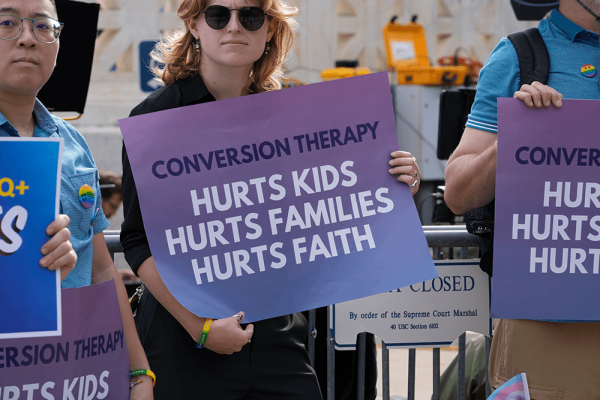As a nation, we have historically celebrated the long, often arduous journey immigrants take to achieve United States citizenship. The promotion of citizenship – which holds the possibility of full membership in our constitutional democracy – has been a goal of successive administrations, and for good reason. A recent study by the Center for Migration Studies (CMS) shows that policies that allow immigrants to advance to more secure and permanent statuses, culminating in naturalization, benefit immigrants, their families, and the nation as a whole.
The study examines how foreign-born persons in different statuses – undocumented persons, non-citizens with legal status (most of them lawful permanent residents), and naturalized citizens – fare by several metrics of integration and socio-economic attainment. It finds that immigrants make enormous steps forward as they graduate from one status to the next, to the point that naturalized citizens equal or exceed U.S.-born citizens by metrics such as:
- A college education or higher for those age 18 and above (35 versus 29 percent)
- Employment for those age 16 or older (96 versus 95 percent)
- Self-employment (12 versus 9 percent)
- Average personal income ($45,600 versus $40,600)
- Health insurance coverage (92 versus 93 percent)
- Homeownership, i.e., having a mortgage or a paid-off mortgage (68 versus 65 percent)
Remarkably, the U.S. legal immigration system, which the Trump administration has repeatedly maligned because it prioritizes the admission of select nuclear family members of U.S. citizens or permanent residents, produces the same percentage of skilled workers (workers with special skills, knowledge, or ability acquired from attending college or from work experience) as the U.S.-born population.
This is all good news for the nation, albeit not unexpected, given the historic success and continued contributions of immigrants to our nation’s life. However, it is sharply at odds with the administration’s rhetoric, policies, and plans, which seek to impede and even reverse the ability of immigrants to move forward toward citizenship.
The administration’s citizenship agenda has had five parts:
1) The Trump administration has sought to divest several populations of status, most prominently Deferred Action for Childhood Arrival (DACA) beneficiaries and more than 90 percent of Temporary Protected Status (TPS) recipients.
2) The administration has opposed legislation that would offer a path to permanent residence for U.S. undocumented or temporary residents, including DACA and TPS recipients, with one recent exception for roughly 4,000 long-term residents from Liberia. It could have proposed, for example, a path to citizenship for some of the 3.7 million immigrants waiting in family-based visa backlogs that in many cases will span decades and lifetimes, or the nearly 4 million parents of U.S. citizens and permanent residents, or the 20 percent of U.S. undocumented residents who have lived in the United States for 20 years or more. However, it has not done so.
3) The administration has created significant new roadblocks to permanent residency, particularly for low-income, working class persons. On Oct. 4, 2019, the president issued a “proclamation” that would condition adjustment to permanent residence on whether an immigrant has or could afford health insurance. CMS’s research shows that roughly half of undocumented U.S. residents lack health insurance, while 82 percent of legal non-citizens have health insurance. Most uninsured, undocumented persons would ultimately obtain healthcare coverage if they could secure permanent residence, but the proclamation would prevent that from happening.
This proposal came on the heels of the administration’s release on Aug. 14, 2019, of its final rule on the “public charge” grounds of inadmissibility. When the public charge rule goes into effect on Feb. 24th, it will become much more difficult for self-sufficient, working class immigrants to secure permanent status. Moreover, the administration has adopted a number of new procedures that have led to processing delays, additional costs, and the large-scale denial of immigration applications and petitions, in what many immigration attorneys view as a backhanded attempt to restrict legal immigration to the United States.
4) The naturalization process has become more difficult and delayed in recent years. Under the administration’s stewardship, application backlogs and processing times have significantly increased. According to a September 2019 report by the Colorado State Advisory Committee to the U.S. Commission on Civil Rights, it would take 25 years at current case completion rates to reduce the 738,148 naturalization backlog to its 2015 size of 380,639. High fees already operate as a disincentive and hard barrier for many immigrants seeking permanent residence or naturalization.
Rather than address this problem, U.S. Citizenship and Immigration Services (USCIS) issued a proposed rule that would increase the fees in the case of an “immediate relative” of a U.S. citizen from $1,760 to $2,750. Additionally, it would increase the naturalization application fee from $725 to $1,170, and would eliminate the option to request a reduced fee. The proposed rule would also transfer fee revenues – more than $200 million in both FY2019 and FY2020 – to fund Immigration and Customs Enforcement (ICE) investigations.
5) The administration has significantly increased funding and staffing to pursue civil and criminal denaturalization cases. Its sweeping immigration enforcement policies already effectively deny U.S. citizen children of undocumented immigrants many of the rights of benefits of citizenship. Its denaturalization policies have made citizenship a less secure status for naturalized citizens as well.
In short, the administration is pursuing every tactic at its disposal – many of which have been temporarily stalled by the courts – to impede the path to citizenship and to reduce legal immigration avenues to the U.S. Not too long ago, candidate Trump, extremist media sources, and immigrant restrictionists regularly attacked President Barack Obama as a lawless, would-be tyrant for establishing the DACA program after Congress failed to pass immigration reform legislation. Yet these same voices now applaud the administration’s executive actions to restrict legal migration in response to congressional inaction.
This administration’s anti-citizenship policies have received less attention than the other pillars of its immigration agenda, such as the border wall; its deportation policies that have returned hundreds to violence and death in recent years; its family separation tactics; the obscenely misnamed Migration Protection Protocols (which according to Human Rights First, has led to “636 public reports of rape, kidnapping, torture, and other violent attacks against asylum seekers and migrants” over the last year); or its efforts to dismantle the U.S. asylum and refugee resettlement programs. Yet its attempts to foreclose the possibility of naturalization for many immigrants may ultimately be just as harmful as these other policies; they represent a grave threat to the American dream and to our cherished ideal of equality before the law.
Got something to say about what you're reading? We value your feedback!







